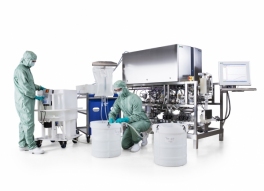
Buffer preparation is still a highly manual activity that often requires a lot of resources due to the large number and overall volume of buffers. With inline conditioning buffers can be prepared inline from buffer concentrates or stock solutions, and directly integrated with the chromatography or filtration step. This eliminates the need for intermediate storage in buffer bags or holding tanks.
This week, Bioprocess Development Forum spoke with Filippo Bertoli, Senior Associate Scientist, Séamus McHugh Operations Manager, Joanne Sheehy Staff Manufacturing Process Specialist, Sean Coomey Principal Process Engineer and Heather Nagle, Staff Technical Operations Engineer from Janssen to better understand their journey moving from manual preparation of buffers to implementing inline conditioning (IC) technology for automated buffer preparation.
What were the main drivers to evaluate a new technology and move from traditional preparation of buffers to inline conditioning (IC)?
One of the primary drivers to evaluate IC was the desire to do more with less. When we started designing the new suite for large-scale manufacturing at our Cork site in Ireland, one of the biggest challenges was accommodating over 170,000 liters of buffers that is needed for the downstream processing of one batch. IC technology is based on the use of concentrated stock solutions and therefore provided an opportunity to reduce buffer volumes, increase buffer capacity and reduce costs.
Could you explain your journey from technology evaluation to implementing IC at your GMP facility?
Our engineering, operations and science departments participated in the equipment design and test together with the Cytiva subject matter experts (SMEs). Our people were able to travel to Sweden for the equipment qualification and perform some preliminary testing there. After we received the equipment on our site, we performed a feasibility study, followed by a validation study and finally, we ran an engineering batch.
We then moved to use the technology in GMP batches. We were fortunate in having a close collaboration with Cytiva and having their SMEs ready to support us, which was a great help during our journey
What were the key challenges throughout this journey and what were the success factors/what worked well?
There were various challenges to overcome during the project, some of the key ones were the work associated with the transition from a classical buffer make up system to a preparation of concentrated stocks with platform and future products in mind. This required integrating new processes like IC calculations, quality management of real-time buffer release, stock solution stability, and so on. Another challenge was the validation of the inline probes and how they would react to the variety of buffers we expose them to during routine processing. However, the project was a success, thanks to the efforts of everyone involved. This project required input from a variety of departments, including engineering, manufacturing operations, research and development, technical operations, and quality assurance and everyone collaborated to their best, making it a success story. The collaboration with Cytiva also greatly helped the process, as having their SMEs supporting us made easy to troubleshoot any possible issue.
Now that the process performance qualification (PPQ) runs have been successful and you have implemented the technology, what do you see as the major advantages with IC?
IC technology has helped us not only to save the costs associated with the preparation of buffers large-scale, but also contributed to reduction of our environmental impact by reducing the number of single-use equipment that we use in the suite. It did also result in process time savings. Finally, it did allow us to release our buffers in real time, thereby allowing us to save testing associated time.
Looking into the future, are there some aspects of the IC technology you want to investigate further, or intend to implement next?
We validated and used in GMP batches IC technology by flow control, we will be looking in future at scoping the other controls mode available (like pH and conductivity feedback control) for use in our manufacturing process, now that the pH and conductivity probes have been validated.